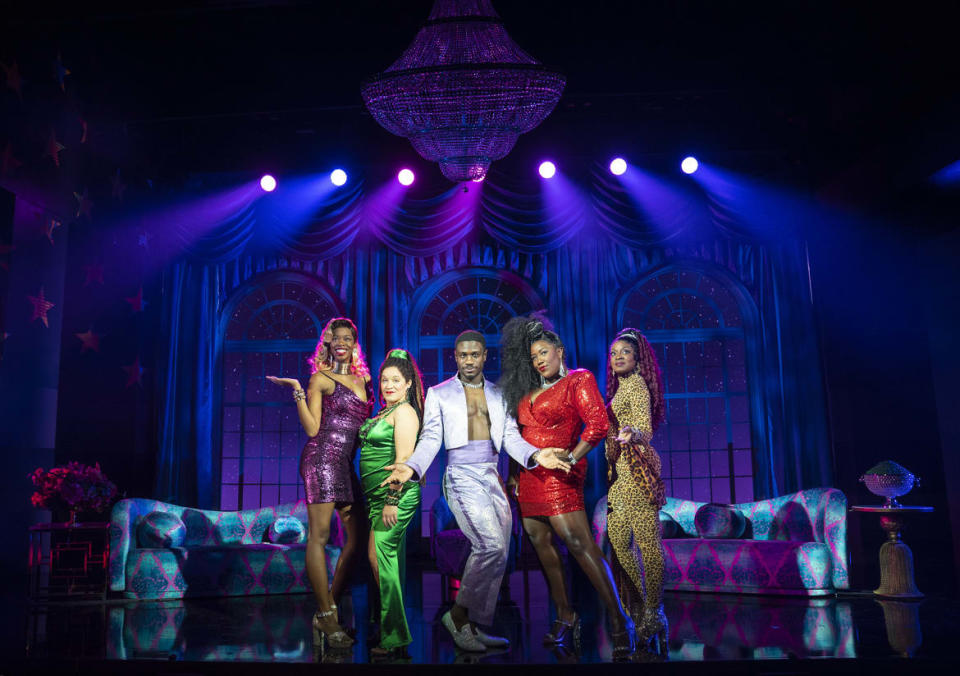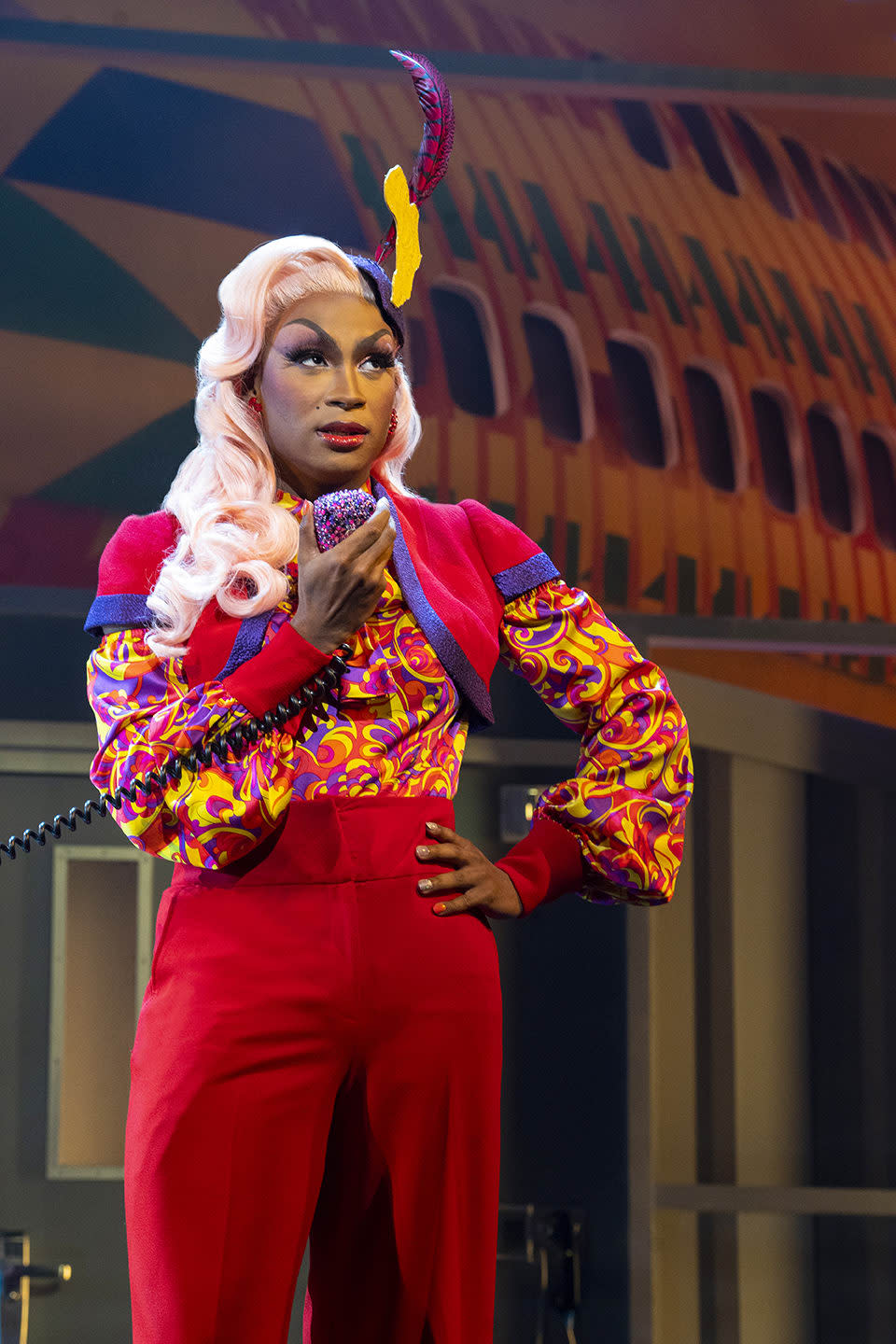‘A Beautiful Noise: The Neil Diamond Musical’ Is a Broadway Concert for the Truly Devoted

- Oops!Something went wrong.Please try again later.
A Beautiful Noise: The Neil Diamond Musical
If you’re a Neil Diamond fan, you’ll be in clover. All around this critic, his devoted faithful waved, pointed to the sky, swayed, whooped, and sang. A Beautiful Noise is a jukebox musical (Broadhurst Theatre, booking to September 3, 2023) only for those who love Neil Diamond—or for people who want to hear “Sweet Caroline” played with theater roof-raising gusto. If you’re not a Neil Diamond fan, you’ll have to figure out how much you want to hear “Sweet Caroline” played with theater roof-raising gusto, and make your ticket-buying choice accordingly.
A Beautiful Noise tries, and fails, to give the conventions of the jukebox musical an innovative shake by starting out with an encounter between the older Diamond (Mark Jacoby) and his therapist (Linda Powell). A note from Diamond himself in the program says the musical is part-dedicated to his late therapist Dr. Lu Katzman, who inspired it.
The encounter between the characters of Diamond and the therapist certainly makes for a genuinely fascinating joust of a cold open, which only becomes more intriguing when dancers begin materializing from beside Diamond’s chair as if out of nowhere—all his creative demons manifested. (Steven Hoggett’s choreography and the dancers are excellent throughout.)
Music Might Help Neil Diamond Fight His Parkinson's Disease
However, these therapy sessions, while played well by Jacoby and Powell, don’t propel the narrative, or have impact. They simply punctuate the musical numbers in which the younger Diamond is played by Will Swenson (Nick Fradiani does the Wednesday evening performances). They’re staging posts between songs, and these Swenson—in Luc Verschueren’s luxuriantly wedged, era-perfect wigs—agreeably imbues with Diamond’s nasal, growly croon. Drama in the show is emphatically non-existent, but the songs—with pulsing lighting by Kevin Adams, sound design by Jessica Paz, and music supervision by Sonny Paladino—are executed with precision. Fans will hear all they want to; there are 30 numbers from “A Beautiful Noise” to “Love on the Rocks.”
In his program note, Diamond says that the idea of a Broadway musical had been “daunting,” until the symptoms of Parkinson’s disease prematurely ended his touring career; “I say ‘prematurely,’ because my heart and soul would tour until the day I die if only my body would co-operate.” This is moving, as the most notable thing associated with his touring in the musical is the deleterious effects it has on his second marriage. Parkinson’s is not mentioned by name or examined in the show—perhaps the assumption is that everyone here knows about it; perhaps the decision was taken not to include it—but when the older Diamond/Jacoby rises to sing “I Am...I Said” at the end, a self-affirming bookend to the therapy he has had, it is stirring and moving.
The older Diamond on stage wards off his doctor’s inquiries, and seems intensely private. The younger Diamond doesn’t reveal much either; we do not really find out who he is beyond the stage figure—even answering basic intrigues like what transformed this very heterosexual man’s costumes from all-black to sequin central (his great costumes are by Emilio Sosa). We see the vaguest outlines of his Jewish upbringing, and his parents’ anxiety.

Will Swenson in 'A Beautiful Noise: The Neil Diamond Musical.'
The story never moves beyond anything deeper than the usual biopic standbys. Here is the young Diamond, shy and sweet who just wants to make music. Indeed, he crafts hits for others. The bit where Diamond ends up signed to the Mafia is played mostly for laughs. Beyond the singing, there is nothing much for Swenson to work with.
The most insulting gaps in the story are around the women in his life, who are underwritten and mired in stereotypes, whether it be Good, Wronged Wife (Jessie Fisher as Jaye Posner), or Siren Homewrecker-Turned-Wife (Robyn Hurder as Marcia Murphey). His third wife, Katie, who we hear is the person who means the most to him, is completely absent. Beyond Diamond first committing adultery, and then touring a lot, his personal life is a deliberate blur.
In his program note, Diamond says watching the show has been therapeutic—“reliving some joyful and some of the painful parts of my life, wishing perhaps that if I could only make a few edits in the script, it would change some of the reality of what I was seeing.” But ultimately it had helped him come to terms with his life, he writes, and to be grateful for all those who are important within it.
This is heartening to know. However, depth and detail are absent from the musical; instead, clichés rule. Watching the show, one wondered if those so transported were watching what was in front of them, or simply worshipping their icon; were they appreciating Swenson, or reveling in hearing the Diamond-ness of it all? Perhaps no one is here for the book, or wants the show to dig deep. Diamond’s fans know what they want to know about him, and just want the songs—and this they get. The answer is in all those swaying hands: this is a tribute concert unconvincingly studded with some words—paradise for Diamond’s fans, but not great theater.

(l to r) Fedna Jacquet, Shannon Matesky, Marchánt Davis, Crystal Lucas-Perry, Ebony Marshall-Oliver in 'Ain't No Mo.'
Ain’t No Mo’
The Obie Award-winning Jordan E. Cooper’s blistering satire about Black identities and the price of racism has kept all its bite and raucous vigor in its transfer to Broadway (Belasco Theatre to Feb 26, 2023), after its acclaimed pre-pandemic run at the Public Theater. Its central conceit is that Black Americans have been offered free plane tickets to leave athe country and return to Africa. Peaches, the flight attendant that Cooper plays in drag, is desperately trying to shepherd the last passengers onto the plane from Gate 1619 (the date of the arrival of the first enslaved Africans in the English colony of Virginia).
Ain’t No Mo’ is a series of sketches, punctuated by Peaches’ efforts at the airport gate, that interrogate the country and circumstances that Black people are leaving, and echoes the structure and themes of George C. Wolfe’s 1986 play The Colored Museum. A supremely excellent, multi-character-playing cast—Fedna Jacquet, Marchánt Davis, Shannon Matesky, Ebony Marshall-Oliver, and Crystal Lucas-Perry—animate these scenes. In the first, set in 2008, Davis plays a preacher, both conducting a funeral for a beloved community activist, and also loudly looking forward to an era of progress under the newly elected President Obama.

Jordan E. Cooper as Peaches in 'Ain't No Mo'.
What unfolds after that—a country where Black people are literally no longer able to live—shows the tragic and insidious frustration of that promise. The jokes and laughter in a sketch skewering conflict-dependent reality shows produce belly laughs—as we see the various deals with the devil the women have made to be famous—but also the white manipulation of Black pain and co-option of identity in “transracial” character called Rachel (inspired by Rachel Dolezal perhaps?), who has changed her name to Rachonda.
Lucas-Perry has two standout moments. In one sketch, she plays the furious spirit of expansive Black identity freed from a rich Black family’s basement to remind them who they are (practically and symbolically, they want her dead at all costs). In another sketch, a moment of relative quiet in the production, she plays a quietly furious prisoner about to be freed to catch the plane, but angry about what has been taken from her and what she cannot find.
It is a gorgeous scene, and finds echoes in the final scene where Peaches is confronted with either rushing for the plane or ensuring the safe-keeping of Miss Bag, a colorful holdall emanating magical powers that contains Black history and multitudes—and which Peaches cannot, will not leave, for white America to take. In Ain’t No Mo’, her impossible choice speaks angry volumes.
Becky Nurse of Salem
This play (Lincoln Center Theater/Mitzi Newhouse, booking to Dec 31) is a weird muddle of themes and moods, but the star—Tony Award-winning Deirdre O’Connell—is, just as she was in Dana H., completely transfixing. She plays Becky, a tour guide at the Salem Museum of Witchcraft in 2016/17, extremely exercised that she, and only she, is the true guardian of the town’s history, and its infamous persecution of a group of women it claimed were witches in 1692.
She is also a proud descendant of one of the persecuted women, Rebecca Nurse, and so it is that the play crisscrosses history and the present day, after Becky seeks improvements in both her professional and personal life via the services of a witch, played by Candy Buckley, massacring every word she says with a Massachusetts-specific drawl. (O’Connell as Becky sounds so spookily like Bette Midler at her most bug-eyed in movies like Outrageous Fortune, you half expect Shelley Long and Peter Coyote to show their faces.)

(l to r) Deirdre O'Connell and Candy Buckley in 'Becky Nurse of Salem.'
Soon having spells put on them are pub owner Bob (Bernard White); Becky’s nemesis Shelby (Tina Benko), a far too caricature-ish bitch figure who runs the museum and talks the game of women’s empowerment while firing Becky; and Becky’s daughter Gail (Alicia Crowder), who wants to have a relationship with the very-slightly older Stan (Julian Sanchez).
The play is witty and sharp in places, particularly in its irreverent and pointed dissection of history, but it switcheroos in a bizarre and unconvincing way from amiable comedy to searing drama taking in opioid addiction (which seems a dramatic device to explain away Becky's crazy dreama rather than something powerful and integral to who she is), justice, and injustice.
The witchery of the past erupts into the present via Becky’s drug withdrawal-caused nightmares after she is jailed for stealing a mannequin from the museum. But this infraction does not really parallel with the Salem witch trials.
However, O’Connell is such a good, transporting actor that even as the drama on stage barrels into cuckoo-land, she grounds it and the audience with Becky’s quirkiness, passion, fierceness, and laughter.
Get the Daily Beast's biggest scoops and scandals delivered right to your inbox. Sign up now.
Stay informed and gain unlimited access to the Daily Beast's unmatched reporting. Subscribe now.

